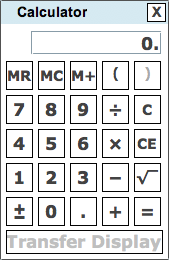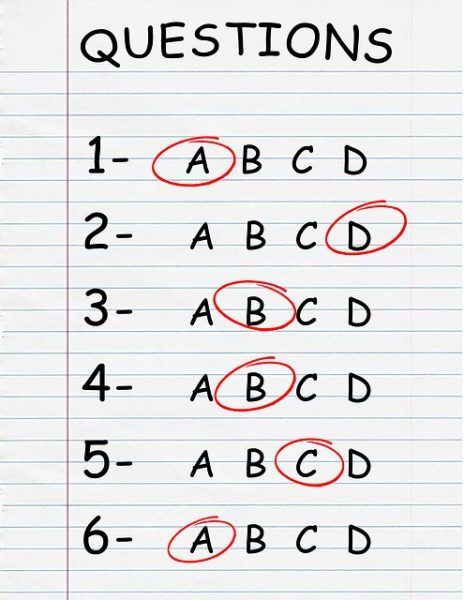
GRE vs SAT: sounds like an epic action movie, right? If you’ve taken the SAT and are currently preparing to take the GRE, you might be wondering how different (and how alike) these two exams really are. After all, both exams contain separate concentrations on reading, writing, and math. But does this mean the GRE is just a regurgitation of what’s on the SAT? Or is the GRE harder than the SAT?
Follow along in our GRE vs SAT guide as we take a look at the 13 key differences (and a few similarities!) between two of the most famous standardized tests. We’ll also investigate how difficult the GRE and SAT really are compared to each other, as well as whether or not your SAT scores can ultimately predict your GRE performance.
GRE vs SAT: 13 Differences
Let’s not waste any time! Below are the 13 major differences between the GRE and SAT, with explanations for each.
#1: Purpose
One of the most obvious differences between the GRE and SAT is their purposes.
In short, the GRE is used for grad admissions, while the SAT is used for undergrad admissions. Because high school juniors and seniors take the SAT and aspiring grad students (i.e., those wishing to pursue a master’s degree or a doctorate) take the GRE, most GRE takers are college graduates or college seniors.
The GRE is the most common standardized test required for grad school admissions. Whether you must take the GRE depends primarily on the programs you’re applying to. Many grad programs in the math and sciences, arts and humanities, and social sciences require or strongly recommend GRE scores.
Quick side note: we've created the world's leading online GRE prep program that adapts to you and your strengths and weaknesses. Not sure what to study? Confused by how to improve your score? We give you minute by minute guide.
You don't NEED a prep program to get a great GRE score. But we believe PrepScholar is the best GRE prep program available right now, especially if you find it hard to organize your study schedule and don't know what to study.
Click here to learn how you can improve your GRE score by 7 points, guaranteed.
By contrast, specialized programs in medicine, business, law, and other fields usually require alternate exams such as the MCAT, GMAT, etc.
#2: Computer vs Paper
Don’t bother sharpening too many pencils this time around. The GRE is predominantly available as a computer-delivered test, whereas the SAT is only available as a paper-delivered test. (In countries where the computer version is unavailable, the GRE can be taken as a paper-delivered test.)
However, the SAT likely won’t remain a paper-delivered test forever. It has been said the College Board is considering offering the SAT as a computer-delivered test sometime in the near future, but nothing is set in stone yet.
#3: Cost
Start saving money because you’re going to be spending a lot more on the GRE than you did the SAT! At $205, the GRE is significantly more expensive than the SAT, which is only $46 or $60 (depending on whether you complete the essay portion or not).
Moreover, additional GRE score reports cost more to send than additional SAT score reports. GRE score reports are $27 per score recipient, whereas SAT score reports are $12 per score recipient.

#4: Availability
The computer-delivered GRE is available year-round at numerous test centers around the world, making it an extremely convenient and ubiquitous test. As a result, you can also retake the GRE fairly often: every 21 days, up to five times in any continuous 365-day period.
As a paper-delivered test, the SAT is less flexible than the GRE and is administered only seven times a year: once a month from October to December and in March, May, June, and August.
#5: Sections
Although both the GRE and SAT test the same overarching topics of reading, writing, and math, their individual sections (and the number of questions in each) differ greatly.
The GRE is composed of four section types, two of which appear twice on the exam:
-
- Analytical Writing (two questions, 60 minutes)
- Verbal Reasoning x2 (20 questions and 30 minutes per section)
- Quantitative Reasoning x2 (20 questions and 35 minutes per section)
- Unscored experimental or research section (either an extra Verbal or Quant section; 20 questions, 30 or 35 minutes)
Because of the unscored section, in total you’ll get either three Verbal and two Quant sections or three Quant and two Verbal sections. The experimental section can come anytime and is not marked or indicated in any way, whereas the research section always comes at the end of the test and contains an indication that it is an unscored section.
On the SAT, there are five sections, all of which appear only once:
-
- Reading (52 questions, 65 minutes)
- Writing and Language (44 questions, 35 minutes)
- Math No Calculator (20 questions, 25 minutes)
- Math Calculator (38 questions, 55 minutes)
- Essay (optional; one question, 50 minutes)
#6: Structure
The GRE and SAT differ significantly in terms of organization.
On the GRE, the Analytical Writing section always comes first. Afterward, the Verbal and Quant sections are completely random! So you could have two Verbal sections followed by two Quant sections or one Verbal, two Quant, and another Verbal (and so on). As mentioned previously, the experimental section is also random (whereas the research section comes at the end).
Meanwhile, the order of the SAT is always the same:
-
- Reading
- Writing and Language
- Math No Calculator
- Math Calculator
- Essay (optional)
Prior to 2016, the SAT was a lot more random. It also used to include an experimental section as the GRE does currently. But since undergoing a heavy facelift last year, the SAT is now (thankfully!) much more predictable. Unfortunately, this means that the GRE is fairly unpredictable (and therefore possibly harder — but we’ll explore this idea more later).

#7: Adaptive Testing
As a computer-delivered test, the GRE uses adaptive testing to alter the difficulty of sections for test takers as they progress through the test. The SAT, however, is a paper-delivered test and therefore doesn’t (and can’t) use adaptive testing.
But what exactly is adaptive testing? On the GRE, each Verbal and Quant section “adapts” to your skills, automatically shifting in difficulty depending on the number of questions you’ve guessed correctly. For example, if you begin with medium-difficulty questions on Verbal and perform extremely well on the section, your next Verbal section will be of a slightly higher difficulty.
#8: Grammar
Unlike the SAT, which tests grammar knowledge via its Writing and Language section, the GRE doesn’t have a section focusing on the mechanics of writing.
On the GRE, Verbal tests your reading comprehension skills and vocab knowledge, while Analytical Writing tests your ability to lay out a cogent analysis or argument. So when you’re given a sentence or passage to analyze on the GRE, you’re being tested on your ability to understand what’s written rather than your ability to improve what’s written.
By contrast, on the SAT’s Writing and Language section, test takers must edit specific passages to improve for grammar, clarity, and overall flow.
#9: Essays
Sure, you’ve got to write essays for both the GRE and SAT, but they’re not actually as similar as they sound.
Here is a table showcasing some of the major differences between the GRE Analytical Writing section and the SAT Essay:
| Section Name | Appearance | # of Essays | Time Allotted | Task(s) | Optional? | |
| SAT | Essay | End of test | 1 | 50 mins total | Analyze argument of passage | Yes |
| GRE | Analytical Writing | Beginning of test | 2 | 30 mins per essay | “Analyze an Issue” and “Analyze an Argument” | No |

#10: On-Screen Calculator vs Physical Calculator
Although you can solve math problems using a calculator on both the GRE and SAT, the GRE (a computer-delivered test) uses an on-screen calculator, while the SAT (a paper-delivered test) uses a physical calculator.
Your on-screen calculator will look like this on the GRE:
Want to improve your GRE score by 7 points? We have the industry's leading GRE prep program. Built by world-class instructors with 99th percentile GRE scores, the program learns your strengths and weaknesses through machine learning data science, then customizes your prep program to you so you get the most effective prep possible.
Try our 5-day full access trial for free:

As you can see, you’ll have access to all basic math functions (addition, subtraction, multiplication, and division) in addition to parentheses and a square root function. You can also click the “Transfer Display” button to transfer your calculator’s display directly to the answer box of a Numeric Entry question. To learn more about how to use the GRE calculator, check out our in-depth guide.
On the SAT, you must bring your own calculator for the math section. In addition, your calculator must be one of the brands and models approved by the College Board. Permissible calculators include a majority of graphing calculators and all scientific calculators.
#11: Calculator vs No Calculator
Again, calculators! On the GRE, you are permitted to use your on-screen calculator for help with any math question on Quant. But the truth is you might not even need the calculator at all because most GRE math questions can be solved without one. If you find the calculator distracting or don’t feel it’s helping you, you may choose to hide it.
The SAT, however, only lets you use a calculator on the Math Calculator section specifically. On the Math No Calculator section, which comes before the Math Calculator section and is significantly shorter, you must solve all math problems by hand. Concepts usually tested in this section include arithmetic, algebra, and geometry.
#12: Vocab
In contrast to the SAT, the GRE dedicates a large portion of its Verbal sections to testing difficult vocab via its Text Completion and Sentence Equivalence questions. Text Completion requires you to understand how a vocab word affects the overall meaning of a sentence, while Sentence Equivalence requires you to select two synonymous vocab words and fill in a sentence.
GRE vocab is typically considered one of the most challenging parts of Verbal. Many GRE prep books offer robust lists of potential vocab words, with some running as high as 3,000 words!
But the SAT doesn’t focus as much on vocab as it once did. Since 2016, the SAT has completely done away with Sentence Completion questions and now only sporadically tests vocab knowledge in the context of entire passages.

#13: Scoring
Finally, the GRE and SAT are scored using entirely different scales.
Let’s start with the GRE. Both Verbal and Quant use the same scale of 130-170 in 1-point increments (on which 130 is the lowest possible score and 170 is the highest). Sectional scores for Verbal and Quant are more commonly presented as separate scores rather than as a single combined score.
On the SAT, the two Math sections are scored together on a scale of 200-800 to get an overall Math score, while the Reading and Writing and Language sections are combined to get an overall Evidence-Based Reading and Writing (EBRW) score (using the same scale of 200-800). Altogether, the Math and EBRW scores combine to produce a total SAT score on a scale of 400-1600 in 10-point increments.
As for the essay sections, both the GRE and SAT give separate writing scores on scales different from the ones they use for reading and math. On the GRE, Analytical Writing uses a scale of 0-6 in half-point increments as an overall score for both essays combined. On the SAT, test takers get three separate scores for their essay, each between 2 and 8 points (so a perfect score would be three 8s).
Side note: the GRE once used a scale similar to what the SAT uses now. Each Verbal and Quant section was scored on a scale of 200-800 in 10-point increments. In 2011, however, the GRE underwent significant revision and established the 130-170 scoring range in use today.
GRE vs SAT: 4 Similarities
So far, our analysis of the SAT vs GRE has provided us with a detailed look at the 13 key differences between the two exams. But are there any similarities, too?
The answer is yes! Below are four ways the GRE and SAT are a lot more alike than you might’ve thought.

#1: Multiple Choice
As is the case with most standardized tests, both the GRE and SAT are predominantly multiple choice. The only non-multiple-choice questions on the exams are the essay portions (for which you have to write entire essays) and a handful of write-in math questions (called Numeric Entry on the GRE and grid-ins on the SAT).
Really, you’re not dealing with anything new on the GRE. It’s still your basic choose-the-best-answer-choice formula!
#2: Reading Comprehension
Similar to the SAT, the GRE has a big focus on reading comprehension. On both tests, you’re given passages of various lengths for which you must answer questions or groups of questions centering on concepts such as theme, tone, vocab, etc.
Therefore, any tricks you used for solving these questions on the SAT can likely be applied to the GRE, too!
#3: Math Topics
For the most part, the math tested on the GRE and SAT is roughly the same.
Interestingly, although the GRE is geared toward college graduates, the GRE only tests middle school and high school math — no mind-boggling college-level concepts. In other words, you won’t have to learn any new math from scratch for the GRE (phew!). Just review your SAT math concepts and you’re good to go!
Here are the four topics tested on GRE Quant:
- Arithmetic
- Algebra
- Geometry
- Data analysis
And here are the four topics tested on SAT Math:
- Heart of Algebra (inequalities, functions, linear equations, etc.)
- Passport to Advanced Math (nonlinear expressions)
- Problem Solving and Data Analysis (percentages, ratios, graphs, etc.)
- Additional Topics (geometry, trigonometry, etc.)
The only major difference between GRE and SAT math is that the GRE has a much larger focus on geometry, while the SAT has more problems dealing with nonlinear expressions. In addition, the SAT dedicates a small percentage of its questions to trigonometry and logarithms, which are entirely absent on the GRE. (Luckily for everyone, neither exam tests calculus!)

#4: Subject Tests
Both the GRE and SAT offer various subject tests for those who’d like to focus on more specific topics. GRE and SAT subject tests are usually only taken by test takers if required or recommended by a specific school or program (either undergrad or grad). These tests focus on a variety of individual topics, such as English literature, math, history, etc.
Want to improve your GRE score by 7+ points?
Check out our best-in-class online GRE prep program. We guarantee your money back if you don't improve your GRE score by 7 points or more.
PrepScholar GRE is entirely online, and it customizes your prep program to your strengths and weaknesses. We also feature 2,000 practice questions, official practice tests, 150 hours of interactive lessons, and 1-on-1 scoring and feedback on your AWA essays.
Check out our 5-day free trial now:
The only major difference? GRE subject tests focus on college-level concepts and are therefore a lot harder than SAT subject tests. Also, the GRE offers predominantly STEM-related tests, while the SAT offers more language and humanities ones. At present, there are six GRE subject tests and 20 SAT subject tests.
So far, in this GRE vs SAT recap, we’ve covered a total of 17 differences and similarities. Now, let’s shift gears for a moment and try to answer some of our other burning questions: is the GRE harder than the SAT? And can your SAT scores predict your GRE scores?
Is the GRE Harder Than the SAT?
In truth, how difficult the SAT vs GRE is depends on a multitude of factors, including how much time you commit to studying, what kinds of topics you excel at, what your approach to standardized tests is, etc. That said, many claim GRE Verbal is harder than SAT Reading, while SAT Math is harder than GRE Quant.
Let’s start with the reading sections. GRE Verbal tends to test more academic and obscure vocab words than SAT Reading. On the GRE, vocab words must be analyzed using minimal context (i.e., in isolated sentences or paragraphs). On top of that, there are hundreds of potential GRE vocab words!
But math is the opposite. Although the GRE and SAT both test a similar pool of math topics, GRE Quant has a much bigger emphasis on arithmetic, basic algebra, and basic geometry, making it slightly easier than SAT Math. Unlike the SAT, the GRE doesn’t test any trigonometry, logarithms, or other upper-level concepts. Often, all you’ll need is a law or formula in order to solve a problem on Quant.
But the GRE can still be considered a more challenging test overall if you take into account its less predictable nature. These days, the SAT follows a rigid structure with 100 percent predictability. But the GRE is a randomized test; you never know which section you’re going to get next or whether your unscored section will be Verbal or Quant. Not knowing the exact order of sections ultimately makes the GRE more difficult to prepare for.

Can Your SAT Performance Predict Your GRE Performance?
Another common SAT vs GRE concern is whether there’s any correlation between SAT scores and GRE scores. And the answer? Not really.
In reality, most people taking the GRE haven’t taken the SAT in at least four or more years. (I didn’t take the GRE until eight years after I took the SAT!) Remember, the GRE expects you to have mastery of obscure vocab and basic math concepts, all of which you might’ve been great at in high school but possibly haven’t studied in several years! In this case, there’s no point in assuming you’ll perform well on the GRE, especially if you haven’t put in any active effort to studying for it.
Moreover, the two tests, albeit similar, have several big differences in structure and format. The GRE is less predictable than the SAT and it’s also entirely computerized. For example, if you’re great at taking paper tests and scored highly on the SAT, you might not do nearly as well on the GRE because you’re not used to taking computerized tests and working with an on-screen calculator.
All of this being said, sometimes standardized tests in general can pose a difficult challenge for people. If you struggled a lot on the SAT — whether it was due to the content, the time constraints, or other factors — it’s possible you’ll face similar struggles on the GRE.
The best way to combat any GRE fears or test-taking anxieties is to study all major GRE topics as often as you can and familiarize yourself with what the GRE specifically tests. This way, you’ll be 100 percent prepared and know exactly what to expect on test day!
What’s Next?
Want GRE study tips? Take a look at our guide to the best GRE prep books of 2016 and get tips on how to craft an ideal GRE study plan just for you!
Do you really need the GRE for grad school? What kinds of applicants are grad schools looking for anyway? Learn everything you need to know about grad school and admissions so you can get into the program of your dreams!
Curious how other exams compare? Check out GRE vs GMAT and ACT vs SAT analyses!
Ready to improve your GRE score by 7 points?
We've written a eBook about the top 5 strategies you must be using to have a shot at improving your GRE score.
Download it for free now:

